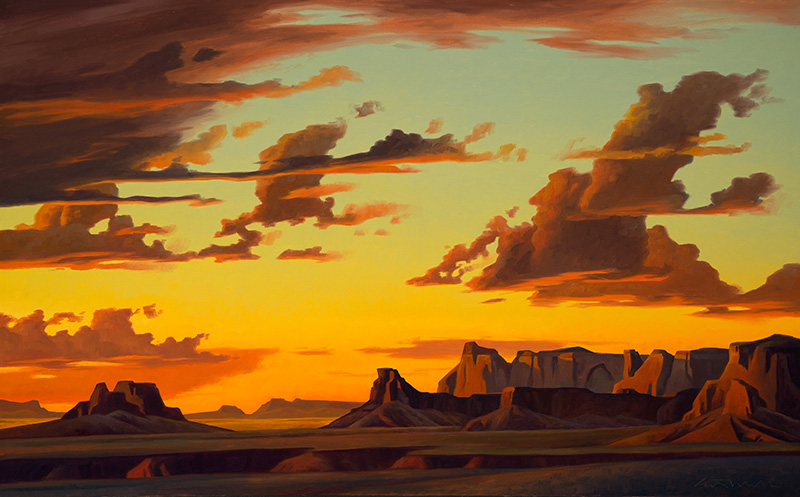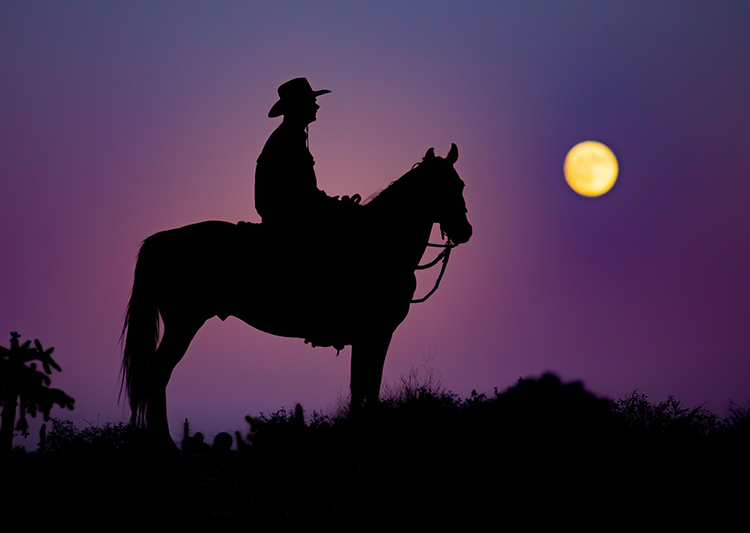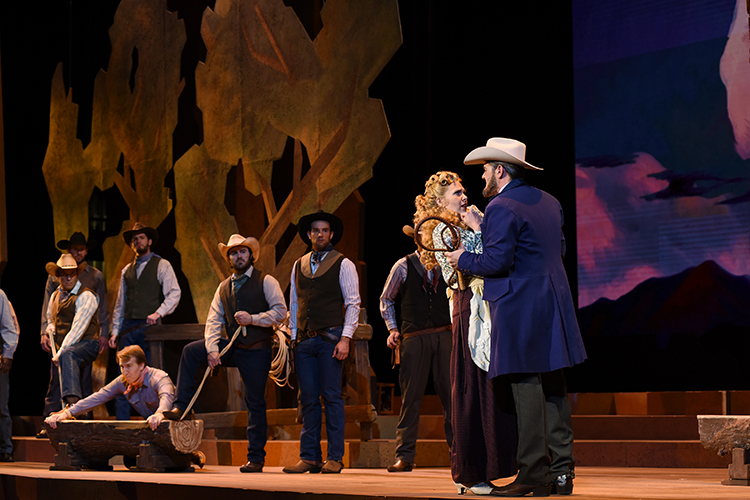Pulling Back the Curtain on a Western Opera

Writer Joseph J. Airdo
[dropcap]E[/dropcap]mmy Award-winning filmmaker Kirstin Atwell Ford has been making movies for more than 25 years.
However, the Arizona native believes that working on her latest project—a documentary about the unprecedented collaboration between three American masters—has been the most transformative experience of her career.
“Riders of the Purple Sage: The Making of a Western Opera” is a documentary about the artistry behind Arizona Opera’s production of “Riders of the Purple Sage”—a fully staged musical adaptation of author Zane Grey’s novel of the same name. The film will celebrate its world premiere 7 p.m. Wednesday, Feb. 5 at Scottsdale Center for the Performing Arts.
Scottsdale’s Museum of the West will host the event, which is part of the city’s annual Western Week that culminates with Parada Del Sol. The museum’s director and CEO Michael J. Fox says that it is his organization’s mission to immerse people in the unique story of the west and that “Riders of the Purple Sage: The Making of a Western Opera” does precisely that.
“The documentary captures a powerful chapter in our regional history and the lasting impact of artists who have expanded the narrative from Old West to the New West,” Fox says.
The Story Behind the Story
“Riders of the Purple Sage: The Making of a Western Opera” briefly begins on opening night of the opera before flashing back in time to composer Craig Bohmler’s initial discovery of Grey’s literary works.
Atwell Ford recalls the dinner conversation she had with Bohmler in 2012 during which he relayed the story of his discovery to her. He told her that he was hiking in Payson when it started to rain so he decided to visit the Rim Country Museum and Zane Grey Cabin.
“He did not really know who Zane Grey was but he discovered that he is the writer who essentially created the Western genre,” says Atwell Ford, noting that Grey not only wrote more than 60 Western novels—many of them based on his experiences in Arizona—but was also one of the first writers to start making films from his novels. “In that way, Grey influenced the worldwide perception of the West.”
Bohmler told Atwell Ford that he was so fascinated by Grey that he was inspired to begin reading “Riders of the Purple Sage”—a novel that when published in 1912 was translated into 20 languages and became an instant worldwide bestseller. It is also the only Western on the Library of Congress’s list of 100 Books That Shaped America.
As Bohmler spoke of how operatic he thought the story was, Atwell Ford’s mind was inherently filled with visions world-renowned landscape painter Ed Mell’s artwork. She shared these visions with Bohmler and the visual environment for an opera inspired by “Riders of the Purple Sage” was hatched.
“Ed Mell works in a very three-dimensional way,” Atwell Ford says. “There is very often a foreground, a mid-ground and a far backdrop. His work really lends itself to being put into a stage environment in three dimensions. He had achieved an unparalleled pinnacle of success in the art world but he had always been interested in designing for the stage so he was excited to come on board.
Atwell Ford then asked Bohmler if he would be open to her documenting the process of the opera coming together for a film. He agreed and shooting began immediately.
Tracing the Artistic Process
Through the film, Atwell Ford analyses the different artistic processes of each major character—Zane Grey, Craig Bohmler and Ed Mell.
“We learn a little bit about who Zane Grey was and his impact,” she explains. “He would take these trips out into Arizona’s backcountry and find locations and characters and fashion stories about them.”
The director followed along as the artistic team behind the opera visited the places that inspired Grey. That, in turn, inspired many of the decisions that they made in the opera.
“We take a look at how the Arizona landscape influenced Craig to write his score and how it influences Ed Mell in his artwork,” Atwell Ford says.
The film continues tracing the artistic process, showing everything from the sets being constructed and the costumes being built to the singers rehearsing and the opera’s director adding her vision to the production.
“It steamrolls into this big moment of opening night where no one is really sure if it is going to work,” Atwell Ford says. “And it played to sold-out audiences who were on their feet every night. The electricity at Symphony Hall was remarkable.”
As if seeing the success of “Riders of the Purple” was not inspiring enough, Atwell Ford had the added benefit of exploring how other artists approach their work while filming her documentary.
“These are artists who are serious professionals,” she says. “Getting to see the inner-workings of their processes has been life-changing.”
Atwell Ford is therefore thrilled for audiences to also reap the benefits of seeing those processes in “Riders of the Purple Sage: The Making of a Western Opera.”
“I am really excited for everyone to come to the world premiere and see something that is meaningful to them in the film—whether it is the landscapes, the paintings, the music, the libretto, the performances or the book itself,” she says. “It is really just an amazing tapestry of one aspect of Arizona’s arts and culture.”
Celebrating Arizona Arts and Culture
After the Feb. 5 world premiere at Scottsdale Center for the Performing Arts, Atwell Ford will take “Riders of the Purple Sage” to the film festival circuit. However, she assures that there will be additional opportunities for audiences to see the documentary later this year.
Additionally, the opera itself is making its triumphant return as part of Arizona Opera’s 2019-20 Main Stage Season with performances scheduled for Feb. 28–March 1 at Symphony Hall in Phoenix.
Joseph Specter, president and general director of Arizona Opera, says that “Riders of the Purple Sage” transformed the organization as well as the community’s perception of its art form.
“We are proud and honored to have a documentary of this caliber capture the creation of Arizona Opera’s first world premiere as we mount the first revival of ‘Riders of the Purple Sage’ on our Main Stage this season,” Specter says.
Atwell Ford believes that “Riders of the Purple Sage” is a cutting-edge piece of theater based on a story that really gets to the root of the American character.
“‘Riders of the Purple Sage’ is a provocative story of the settling of the West,” she says. “It is our story told through the writing, music and paintings of some of our nation’s finest artists. In centuries to come, it will be known as Arizona’s distinct cultural contribution to the art form of opera.”
She feels unparalleled passion for the opera as well as for her film—which she says has been a large-yet-rewarding endeavor.
“It has been just a phenomenal experience,” the filmmaker explains. “Everyone who has come on board the film and the opera itself has some type of family history in Arizona and recognizes that ‘Riders of the Purple Sage’ is our opportunity to highlight the world-class work that Arizona artists do and really celebrate Arizona arts and culture.”
“Riders of the Purple Sage: The Making of a Western Opera”
Wednesday, Feb. 5 | 7 p.m. | Scottsdale Center for the Performing Arts | 7380 E. 2nd St., Scottsdale | $18 | 480-499-8587 | scottsdaleperformingarts.org
“Riders of the Purple Sage”
Feb. 28–March 1 | See website for times | Symphony Hall | 75 N. 2nd St., Phoenix | $35+ | 602-266-7464 | azopera.org



